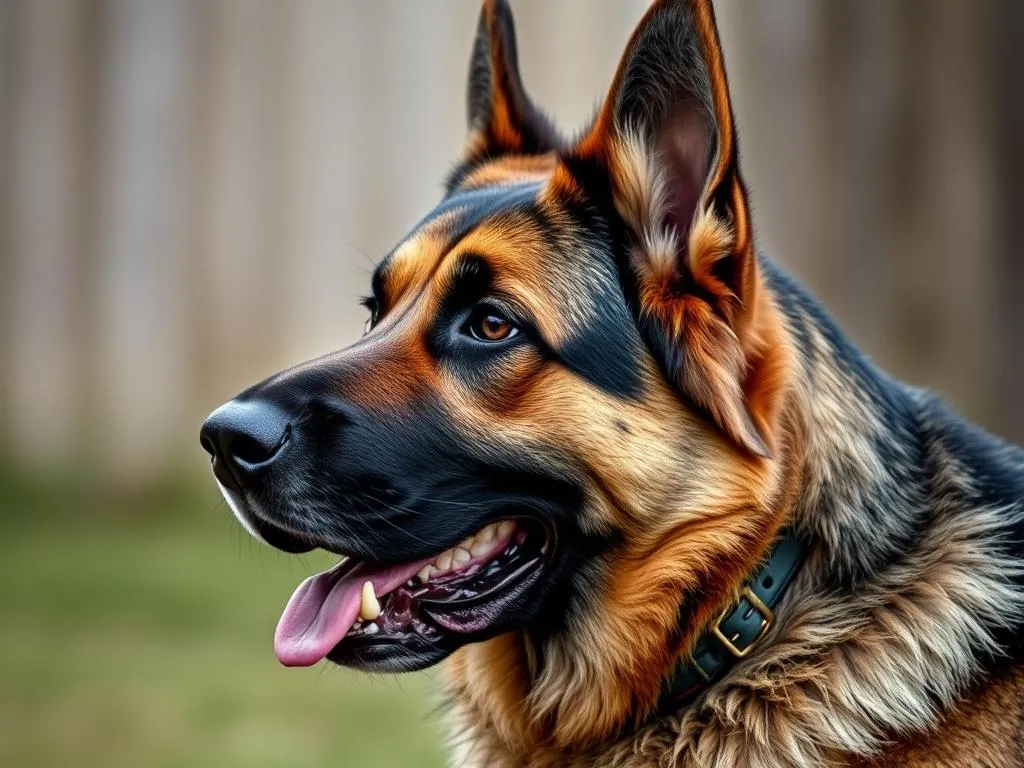
Introduction
The German Shepherd and Mastiff are two iconic dog breeds, each boasting unique traits that make them beloved companions. The German Shepherd, known for its intelligence and versatility, often serves in roles such as police and service dog. On the other hand, the Mastiff, with its imposing size and gentle disposition, is renowned for its protective instincts and loyalty. When these two breeds are mixed, you get the German Shepherd Mastiff mix, a dog that combines the best qualities of both parents.
This article aims to provide detailed information about the German Shepherd Mastiff mix, covering everything from its characteristics to care requirements. Understanding mixed breeds is crucial for potential dog owners, as it helps in making informed decisions about pet ownership.
Understanding the Parent Breeds
German Shepherd
The German Shepherd originated in Germany in the late 19th century, primarily bred for herding sheep. Over the years, it has become a versatile working dog, excelling in various roles due to its intelligence and trainability.
Key characteristics of the German Shepherd include:
- Size: Typically weighing between 50 to 90 pounds and standing 22 to 26 inches tall.
- Temperament: Known for being loyal, courageous, and protective. They are also highly trainable and eager to please.
- Intelligence: Ranked among the most intelligent dog breeds, German Shepherds are quick learners and excel in obedience training.
However, this breed is prone to certain health issues, such as hip dysplasia, elbow dysplasia, and degenerative myelopathy. Regular veterinary check-ups are essential to monitor these potential health concerns.
Mastiff
The Mastiff is an ancient breed that dates back thousands of years, known for its role as a guardian and protector. Originating from England, this breed was used for guarding estates and fighting alongside warriors.
Key characteristics of the Mastiff include:
- Size: A giant breed, typically weighing between 120 to 230 pounds and standing 27 to 32 inches tall.
- Temperament: Mastiffs are known for their gentle and calm demeanor. They are protective of their families but can be reserved with strangers.
- Protective Instincts: This breed is naturally protective, making them excellent watchdogs.
Mastiffs are also susceptible to health issues, such as hip and elbow dysplasia, heart problems, and certain types of cancer. Regular veterinary care is vital to ensure their well-being.
The German Shepherd Mastiff Mix
Physical Characteristics
The German Shepherd Mastiff mix inherits physical traits from both parent breeds, resulting in a striking appearance.
- Size Range: This mix typically ranges from medium to large in size. You can expect them to weigh between 70 to 150 pounds, depending on which parent breed they take after more.
- Coat Type and Color Variations: The mix may inherit the short coat of the German Shepherd or the longer, coarser coat of the Mastiff. Common colors include black, tan, brindle, and fawn, with possible combinations of these colors.
- Distinctive Features: You might notice a strong, muscular build characteristic of Mastiffs along with the erect ears and expressive eyes of the German Shepherd.
Temperament and Behavior
The temperament of the German Shepherd Mastiff mix can vary widely but generally exhibits a blend of loyalty, courage, and protectiveness.
- Typical Behavior Traits: These dogs tend to be affectionate and loyal to their families, often forming strong bonds with their owners. They can be reserved with strangers but are typically gentle and good-natured.
- Socialization Needs: Early socialization is crucial. These dogs can be protective, so exposing them to various environments, people, and pets can help develop a well-rounded personality.
- Compatibility with Children and Other Pets: This mix generally does well with children and can be good family pets. However, supervision is always recommended, especially with smaller animals.
Health Considerations
Common Health Issues in the Mix
Like any mixed breed, the German Shepherd Mastiff mix can inherit health issues from both parent breeds. Some potential genetic health concerns include:
- Hip and Elbow Dysplasia: Common in both breeds, these conditions can lead to joint pain and mobility issues.
- Heart Problems: Mastiffs are particularly prone to heart diseases, and mixed breeds can carry this risk as well.
- Bloat: A life-threatening condition seen in larger breeds, bloat can occur when the stomach fills with gas and twists.
Regular veterinary check-ups are essential in monitoring these potential health issues.
Lifespan and Care Requirements
The average lifespan of a German Shepherd Mastiff mix is around 10 to 12 years, influenced by genetics, diet, and overall care.
- Nutritional Needs: A balanced diet is crucial. High-quality dog food that meets their size and activity level is essential to maintain optimal health. Consult with your veterinarian for specific dietary recommendations.
- Exercise Requirements: This mix typically requires moderate to high levels of exercise. Daily walks, playtime, and mental stimulation are critical in keeping them healthy and happy.
Training and Socialization
Importance of Early Training
Training is vital for the German Shepherd Mastiff mix. Early training helps establish good behavior patterns and strengthens the bond between the dog and owner.
- Benefits of Training: Training can prevent behavioral issues and enhance the dog’s social skills, making them more adaptable to various situations.
- Recommended Training Methods: Positive reinforcement methods work best, utilizing treats and praise to encourage desired behaviors. Consistent training sessions help reinforce learning.
Socialization Strategies
Socialization is essential for this mix to develop into a well-rounded dog.
- Tips for Socializing: Introduce your dog to different people, environments, and other animals early on. Puppy classes or dog parks can be excellent venues for socialization.
- Importance of Exposure: The more experiences your dog has, the more confident and well-adjusted they will become.
Living with a German Shepherd Mastiff Mix
Ideal Living Conditions
The German Shepherd Mastiff mix can adapt to various living conditions but has specific needs.
- Space Requirements: While they can live in apartments, having a house with a yard is ideal. These dogs need space to move and play.
- Climate Considerations: This mix may thrive in a range of climates, but it’s essential to monitor them in extreme heat or cold. Proper shelter and hydration are necessary.
Grooming Needs
Grooming can vary depending on the coat type inherited from the parent breeds.
- Frequency and Type of Grooming: Generally, regular brushing is needed to reduce shedding, especially during seasonal changes. Bathing should be done as needed, usually every few months.
- Specific Grooming Tools: A slicker brush and a deshedding tool can be helpful in managing their coat. Nail trimming and ear cleaning should also be part of the grooming routine.
Pros and Cons of Owning a German Shepherd Mastiff Mix
Advantages
There are numerous advantages to owning a German Shepherd Mastiff mix.
- Unique Blend of Traits: This mix combines the intelligence and trainability of the German Shepherd with the gentle, protective nature of the Mastiff, creating a well-rounded companion.
- Loyalty and Protective Nature: They often form strong bonds with their families, making them excellent family pets and guardians.
Disadvantages
However, potential owners should consider some challenges.
- Potential Training and Socialization Challenges: If not trained and socialized early, this mix may develop behavioral issues, especially due to their protective instincts.
- Health Considerations and Care Costs: Regular veterinary care and potential health issues can lead to higher costs over the dog’s lifetime.
Conclusion
In summary, the German Shepherd Mastiff mix is a unique and fascinating breed that offers a wonderful combination of traits from both parent breeds. With proper care, training, and socialization, this mix can be a loyal, loving family member. However, potential dog owners must consider their living situation, lifestyle, and ability to meet the dog’s needs before deciding to bring one of these dogs into their home. Understanding the characteristics and requirements of this mixed breed will help ensure a happy and fulfilling life for both the dog and its owner.









